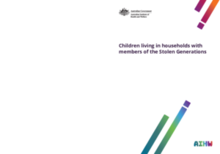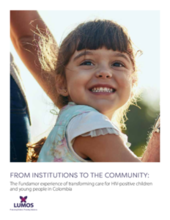Displaying 791 - 800 of 2214
The aim of the presentation is to describe the personal features of non-kinship foster care children who have visits with their birth family in Málaga, Granada and Jaén (provinces of Andalusia, Spain).
The aim of the presentation is to describe the personal features of biological families whose children are in non-kinship foster care and with whom they have face-to-face contact in Málaga, Granada and Jaén (provinces of Andalusia, Spain).
This report presents analyses of selected outcomes for Aboriginal and Torres Strait Islander children who live in households with members of the Stolen Generations.
This report documents Fundamor's process of closing its institution in Colombia and moving children to family-based care, drawing out successes and challenges.
Este informe documenta el proceso de la organización Fundamor a cerrar su internado y, con el apoyo de Lumos, reubicar a los niños y niñas internos en nuevas modalidades de atención familiar.
The aims of this study were (1) to estimate child welfare characteristics in a sample of homeless young people in the US who engaged in commercial sex (CS); and (2) to compare young people who were sex trafficked (ST) to those who engaged in some other form of CS.
There is little Australian research on the factors that influence decisions to adopt children from out‐of‐home care. This paper presents a mixed methods study that was conducted to address this gap.
As part of a 3‐year US federal project of family group conferences (FGCs) in one jurisdiction, this study collected fidelity data from professional and family member participants of FGCs, including children and young people. Descriptive data from a small sample of child and young people participating in FGC suggest differences in their perspectives regarding family empowerment, transparency, and inclusion in decision making, when compared with the perspectives of other family members and professionals for whom data are available.
In this article the authors attempt to disentangle different aspects of potentially harmful care for looked after children, as well as to discuss potential pathways to more systematically approach and report adverse events for this group.
In France more than 140 000 children live in foster homes under the responsibility of the French Child Protection Agency. These children have lived in environments that cannot be good for their development and have been separated from their families which have to have consequences on their mental development. A literature review in France and abroad was made to identify the profiles of these children, their risk factors, and the mental disorders they can present.



